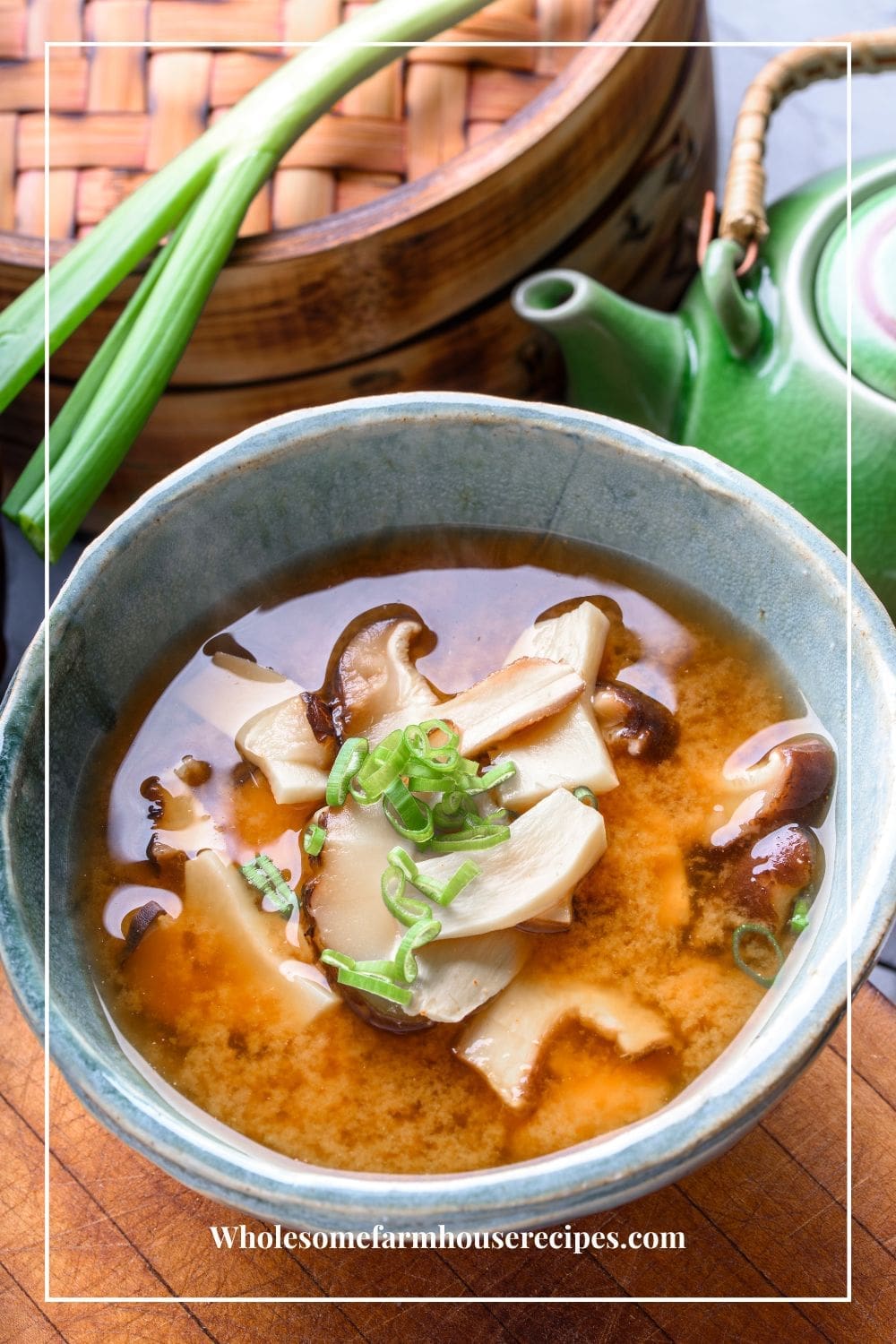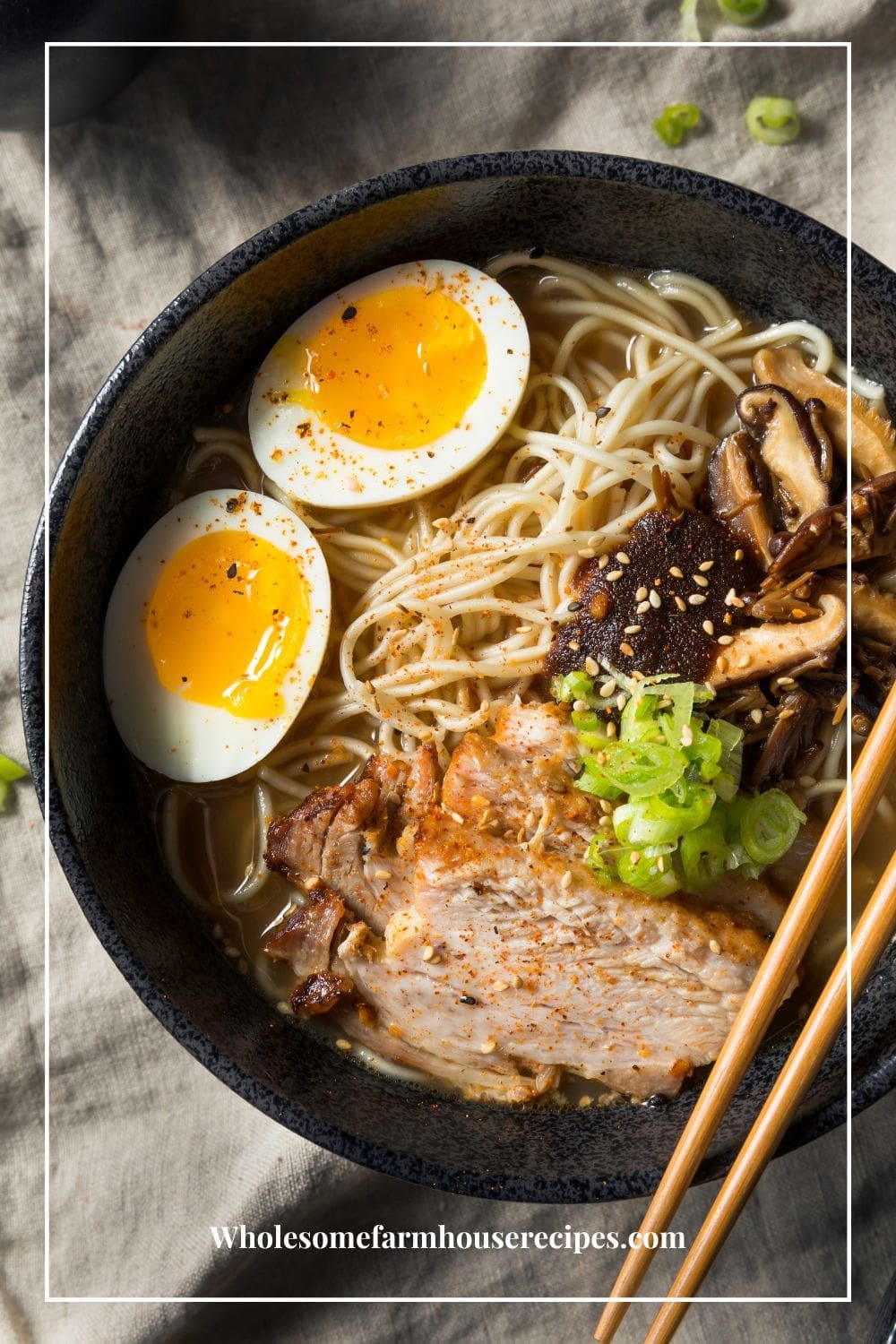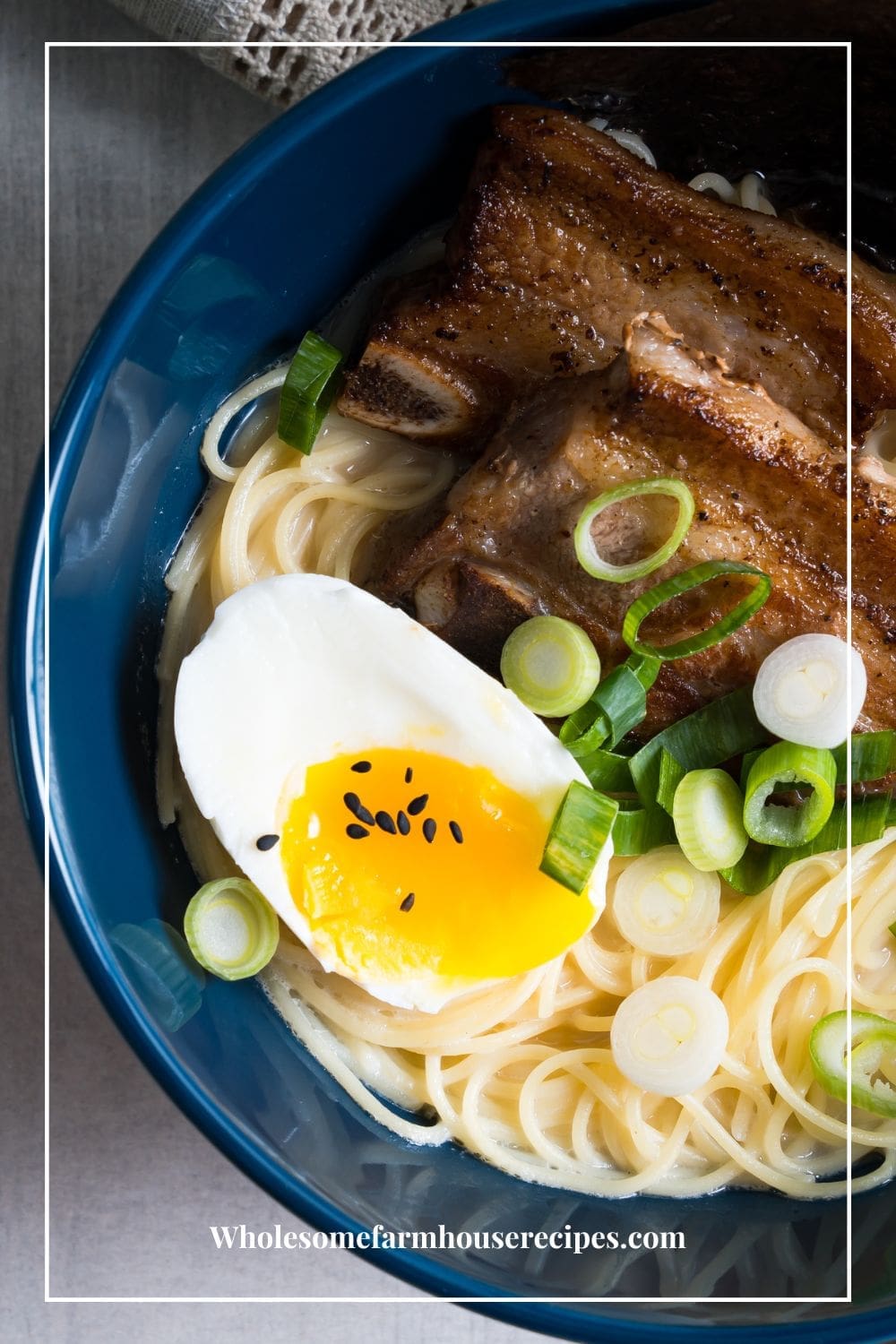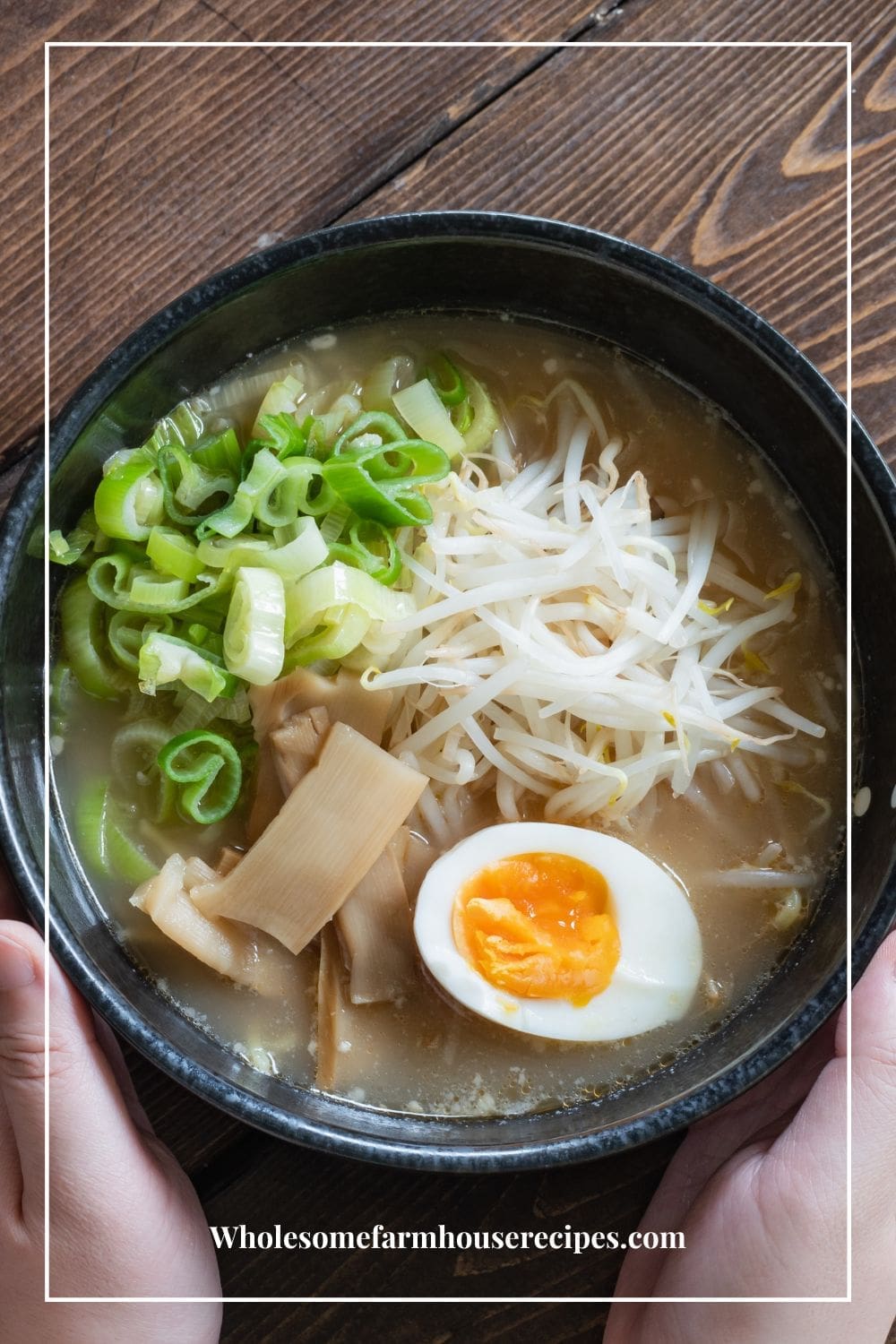The world has fallen in love with different types of ramen broth: Shio, Shoyu, Miso and Tonkotsu. The popularity of Japanese these ramen dishes is due to its flavorful broth, chewy noodles, and diverse toppings.
Additionally, the dish has a rich cultural history and has been adapted in unique ways around the world.
If you have never had the pleasure of enjoying a hot bowl of Ramen, you need to try this. You’re missing out on a delicious ramen experience.
There are a few common broths providing the base for most ramen, these four types of ramen are considered to be the main players in pulled noodle soup.
A big bowl of Ramen has become a comfort food for us. It is a very budget friendly meal too. This is one of the reasons that Instant Ramen is so popular with folks from their college dorm days.
What are the ingredients used to make ramen?
Ramen is a Japanese noodle soup dish that typically consists of Chinese-style wheat noodles served in a meat or fish-based broth, often flavored with soy sauce or miso, and topped with ingredients such as sliced pork, dried seaweed, and green onions.

What is Shio Ramen?
Shio ramen is a type of Japanese noodle soup that is seasoned with salt (shio in Japanese).
The broth for shio ramen is typically clear and light, and made from chicken, pork, or seafood. The noodles used in shio ramen are usually thin, straight noodles that are firm.
Toppings can vary, but may include sliced pork, green onions, bamboo shoots, seaweed, and a soft boiled egg. Shio ramen is known for its delicate and refreshing flavor and is a popular choice among ramen enthusiasts. It is one of the four main types of ramen, along with shoyu, miso, and tonkotsu.
What is Shoyu Ramen?
Shoyu ramen is a type of Japanese noodle soup that features a clear, savory broth made from soy sauce and a main ingredientsuch as chicken, pork, and vegetables.
The noodles used in shoyu ramen are typically thin noodles that are curly. The dish is often garnished with sliced green onions, nori seaweed, and tender slices of chashu pork.
Shoyu ramen is a popular and traditional dish in Japan, and it has gained popularity around the world due to its delicious and comforting flavor.
It is often enjoyed as a hearty meal during colder months or as a satisfying lunch option.

What is Miso Ramen?
Miso ramen is the most popular ramen type. It is a Japanese noodle soup dish that is made with a savory miso-based broth.
The broth is typically made by combining miso paste with a meat or vegetable stock, and it is seasoned with soy sauce, sake, mirin, and other ingredients.
The soup also contains chewy wheat flour noodles, sliced pork, bean sprouts, green onions, and other toppings such as corn or bamboo shoots.
Miso ramen has a rich and hearty flavor that is both comforting and satisfying, and it has become a favorite dish for many people around the world.

What is Tonkotsu Ramen?
Tonkotsu ramen is a popular Japanese noodle dish that originated in Fukuoka city on the southern island of Kyushu.
The dish is known for its rich, creamy pork broth that is made by boiling pork bones for several hours. The broth is then seasoned with soy sauce, miso, or salt and served with thin, curly noodles, sliced pork belly, and various toppings such as green onions, bamboo shoots, and seaweed.
Tonkotsu ramen is a hearty and satisfying meal that has gained popularity all over Japan and around the world.
It is often enjoyed in casual, bustling ramen shops where diners can savor its flavors and warmth.
Miso Ramen VS Tonkotsu Ramen
Miso ramen and Tonkotsu ramen are two of the most popular types of ramen in Japan.
However, Miso ramen is a soup made with a base of fermented bean paste, or miso, and chicken or pork broth. It is typically topped with sliced pork, green onions, bamboo shoots, and bean sprouts.
Tonkotsu broth ramen, on the other hand, is made with a rich and creamy pork bone broth. It is often topped with sliced pork, soft-boiled eggs, and green onions.
The main difference between these two types of ramen dishes is the type of broth.
Miso ramen has a savory, umami flavor that is slightly sweet and salty. It is a good option for those who prefer a lighter broth with a more complex flavor.
Tonkotsu ramen, on the other hand, has a much richer and creamier broth that is almost milky in texture. It is a great choice for those who like a hearty and filling soup.
Another difference between miso ramen and tonkotsu ramen is the toppings. While both types of ramen are typically topped with sliced pork and green onions, miso ramen often includes bean sprouts and bamboo shoots. Whereas tonkotsu ramen may include soft-boiled eggs and nori seaweed.
Overall, both miso ramen and tonkotsu ramen are delicious and satisfying options for ramen lovers.
The choice between the two ultimately comes down to personal preference, whether you prefer a lighter, more complex broth, or a rich and creamy one.

Shoyu Ramen VS Miso Ramen
Shoyu ramen and miso ramen are both popular types of Japanese noodle soup dishes. However, Shoyu ramen is a soy sauce-based broth. It is typically a clear broth that is light in color, while miso ramen is a broth made with fermented soybean paste, giving it a richer, creamier texture and a deeper flavor.
In terms of toppings, shoyu ramen typically features sliced roast pork, bamboo shoots, green onions, and a soft-boiled egg. While miso ramen often includes corn, bean sprouts, and butter in addition to the standard toppings.
While both types of ramen have their own distinct flavor profiles, it ultimately comes down to personal preference.
Shoyu ramen is a great choice for those who prefer a lighter, and cleaner taste.
Miso ramen is perfect for those who enjoy a heartier, and more savory flavor.
Overall, shoyu ramen and miso ramen are both delicious Types of Ramen Broth and popular choices for anyone looking to enjoy a warm and comforting bowl of Japanese noodle soup.

How to Store Miso Paste?
The best way to store miso paste in the refrigerator is to keep it in an airtight container, such as a glass jar or a plastic container with a tight-fitting lid. It should be stored in the refrigerator’s vegetable crisper or on the bottom shelf, where the temperature is more consistent. It can also be stored in the freezer for longer-term storage.
When storing this paste properly, it will last several months in the fridge.
How Long Does Miso Last in the Fridge?
Miso paste should be stored in the refrigerator in an airtight container. It can last for several months in the fridge if stored properly.
Are there any Miso Substitutes?
Yes, there are some miso substitutes that can be used in recipes. Some options include soy sauce, tahini, vegetable stock, or even anchovy paste (if not cooking for vegetarians). The best substitute will depend on the recipe and the desired flavor profile.
What to Serve with Miso Soup for Dinner?
Miso soup is often served as an appetizer or a side dish in Japanese cuisine. Some popular dishes to serve with miso soup for dinner include sushi, tempura, teriyaki chicken, stir-fried vegetables, or grilled fish. Additionally, a simple side salad or steamed rice can also complement miso soup well.
Ingredients in Miso Noodle Soup
If you love the comforting and warming flavors of traditional Japanese cuisine, miso noodle soup is a dish that should be on your to-make list. It’s easy to prepare and packed with deliciousness!
Made with only a few basic ingredients, this simple yet flavor-packed dish makes for an excellent meal or side.
Chicken Broth, Miso Paste, Ginger, Garlic, Soy Sauce, Sesame Oil, Dried Ramen Noodles, Mushrooms, Baby Spinach, Green Onions, and Cilantro.
Make This a Vegetarian Miso Ramen Soup Recipe
Change up your usual soup routine with miso noodle soup. Make it vegetarian too. It is delicious and nutritious Japanese dish that can be made in no time.
Use the recipe below and swap out the chicken broth for vegetable broth. Continue with the rest of the ingredients.
What are extra ingredients and topping ideas for ramen soup?
Some extra ingredients and ramen toppings for this full flavor soup. They include sliced pork, boiled egg, sliced green onions, bean sprouts, mushrooms, nori, and sesame seeds. You can also add chili oil, soy sauce, or miso paste for extra flavor. Sometimes, we add a hard-boiled egg rather than a soft-boiled egg. Just for more protein, flavor, and chewy heartiness to the soup.
This comforting bowl of flavorful broth, noodles, and veggies is packed with vitamins and minerals, perfect for an easy weeknight meal or an elevated weekend dinner.
Miso Noodle Soup Recipe
As an Amazon Associate I earn from qualifying purchases.
Kitchen Essentials
Ingredients
- 4 Cups Chicken Broth or Vegetable Broth
- 2 Tablespoons Miso Paste
- 1 Tablespoon Ginger Grated
- 2 Cloves Garlic Minced
- 2 Tablespoons Soy Sauce
- 1 Teaspoon Sesame Oil
- 4 Ounces Dried Ramen Noodles Cooked according to package directions
- 1 Cup Mushrooms Sliced
- 2 Cups Baby Spinach
- 2 Green Onions Sliced
- 1/4 Cup Cilantro Chopped
Instructions
- In a pot, bring the broth to a boil on high heat and reduce the heat to low.
- In a small bowl, whisk the miso paste, ginger, garlic, soy sauce, and sesame oil.
- Add the miso mixture to the pot and stir well.
- Cook the noodles according to package instructions and drain.
- Add the cooked noodles, mushrooms, and spinach to the pot.
- Bring the soup to a simmer and cook for 5-7 minutes, until the vegetables are tender.
- Ladle the soup into bowls and top with sliced green onions and cilantro. Enjoy!








